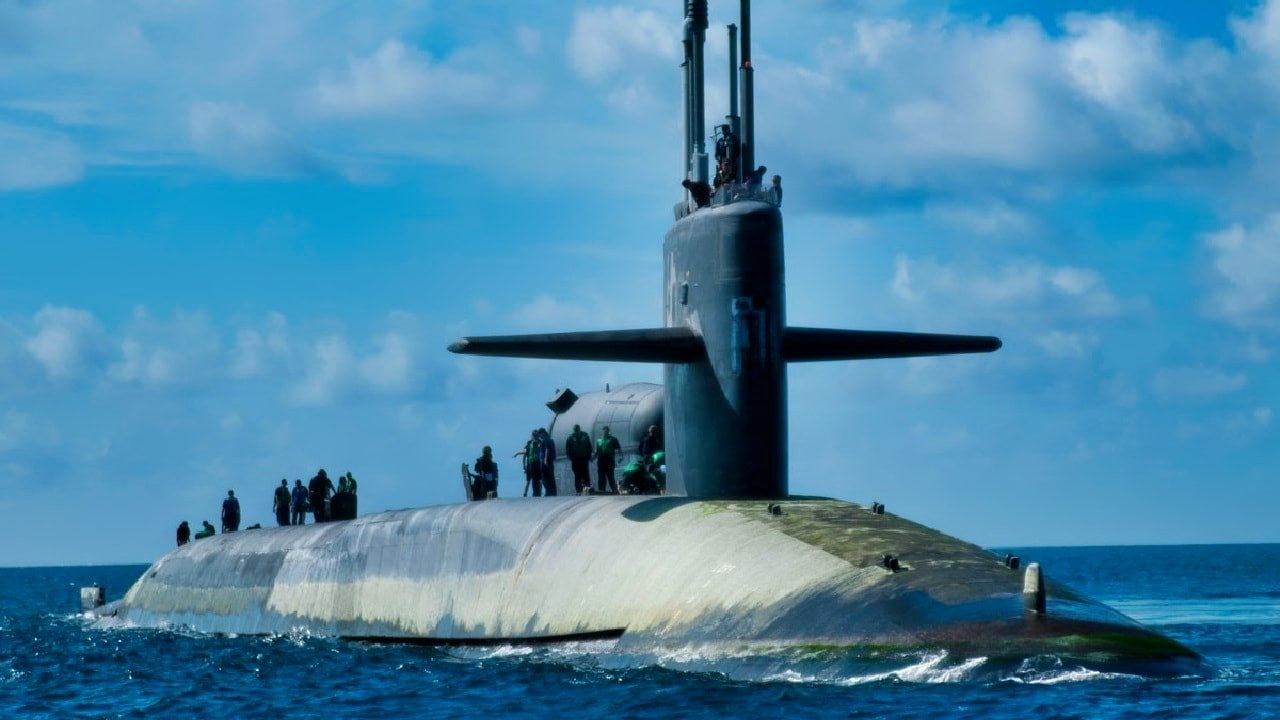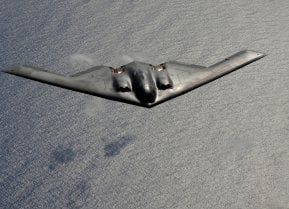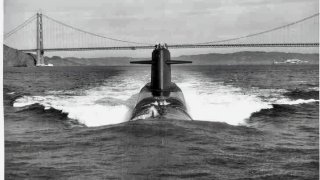The U.S. Navy's Lafayette-Class Submarines Were Oozing with Firepower
The Lafeyette-Class was capable of reaching diving depths of 1,300 feet. The boat operated with two crews, each consisting of 14 officers and 126 enlisted sailors. Fully armed, the Lafeyette could carry 16 nuclear missiles and 12 torpedoes.
Lafayette- Class Submarine: A Complete History - During the Cold War, the US invested heavily in nuclear deterrence. The investment was understandable, given that the US was engaged in a bipolar competition for global dominance against the Soviet Union, and that the Soviets had compiled an extensive stockpile of nuclear weapons.
The Americans developed and relied upon a “nuclear triad” – three options for delivering nuclear weapons: missiles, bombers, and submarines. The Air Force controlled both the missiles and bombers, while the Navy controlled the submarines.
During the 1960s, 70s, and 80s, as the Cold War hit a crescendo, the Navy’s primary contribution to the nuclear triad was the Lafeyette-class ballistic missile submarine.
The ballistic missile submarine, explained
As the name implies, a ballistic missile submarine is a submarine capable of deploying submarine-launched ballistic missiles (SLBMs) tipped with nuclear warheads. Ballistic missiles subs were a highly emphasized weapon system during the Cold War because of the sub’s ability to provide nuclear deterrence. Ballistic missiles subs became so valuable because they were difficult to track – yet could fire nuclear-tipped missiles with accuracy from thousands of miles away. The result was essentially a mobile nuclear launch system with stealth capabilities – something the enemy had a very difficult time accounting for, and was forced to (accurately) assume was lurking nearby. Additionally, ballistic submarines were valuable because they had the ability to survive a first strike, ensuring the possibility of a second strike, and in doing so, enabling the deterrence policy of “mutual assured destruction,” or MAD.
The Lafeyette-class was one of the preeminent ballistic missiles submarines during the Cold War.
Introducing the Lafeyette-class
The Lafeyette was a larger (and improved) version of the preceding Ethan Allen-class. The Lafeyette had multiple builders – General Dynamics Electric Boat, Mare Island Naval Shipyard, and Newport News Shipbuilding and Drydock Co. – all working simultaneously in 1961 and 1962 to launch what would become the entire nine-boat fleet of Lafeyette-class submarines.
The first eight Lafeyette submarines were deployed with the Polaris A-2 missile, which was the Navy’s first SLBM. The Polaris A-2 was a two-stage, solid-fueled, nuclear-armed, submarine-launched missile used from 1961 until 1980. When the A-2 was phased out, in favor of the longer-ranged Polaris A-3, the Lafeyette-class temporarily upgraded to the new Polaris missile, before ultimately settling on the Poseidon C3 missile – which offered significant improvements in missile accuracy.
To facilitate the firing of SLBMs, the Lafeyette was outfitted with a hovering system that managed the submarine’s trim while she was firing. The hovering system helped the Lafeyette to improve her rate of fire from one SLBM per minute to four SLBMs per minute – enhancing the boat’s destruction promise and, in turn, her deterrent capabilities.
General characteristics
The Lafeyette measured 425 feet long with a 33-foot beam and a 28-foot draft. The submarine displaced 8,383 tons when submerged. For propulsion, the Lafeyette relied upon one S5W pressurized water reactor powering 2 geared steam turbines. The result was a submarine capable of generating 15,000 horsepower and 11,000 kilowatts and achieving speeds of 21 knots when submerged.
The Lafeyette wasn’t especially fast – attack submarines regularly reach speeds into the 30-knot range, with some Soviet titanium-hulled subs, like the Alfa, exceeding 40 knots. But speed wasn’t the point of the Lafeyette; she wasn’t built for intercepting or engaging enemy submarines or ships. The Lafeyette was built to lurk with nuclear weapons on standby and to provide nuclear deterrence – and for such a purpose, 21 knots was sufficient.
The Lafeyette was capable of reaching diving depths of 1,300 feet. The boat operated with two crews, each consisting of 14 officers and 126 enlisted sailors. Fully armed, the Lafeyette could carry 16 nuclear missiles and 12 torpedoes.
The Lafeyette-Class in service
All nine Lafeyette submarines were commissioned in either 1963 or 1964. The first Lafeyette commissioned was the Lafeyette flagship (SSBN-616) on April 23, 1963. The Nathan Hale (SSBN-623) was commissioned on November 23, 1963 – just one day after former sailor John F. Kennedy was assassinated in Dallas. The John Adams (SSBN-620), commissioned on May 12, 1964, was the last Lafeyette commissioned.
Gradually, the nine Lafeyette submarines fell out of service, being decommissioned one by one between 1986 and 1992. The Lafeyette submarines were decommissioned for a variety of factors: SALT II treaty limitations, the launch of the US Navy’s new preeminent ballistic missile sub, the Ohio-class (see below), and of course, the collapse of the Soviet Union.

Eight of the Lafeyette submarines have been disposed. The lone exception is the Daniel Webster (SSBN-626), which was decommissioned on August 30, 1990, and converted into a Moored Training Ship (MTS-626), and docked at the Navy’s Nuclear Power Training Unit in Charleston, South Carolina – the last surviving example of the once proud Lafeyette-class submarine.
About the Author: Harrison Kass
Harrison Kass is a defense and national security writer with over 1,000 total pieces on issues involving global affairs. An attorney, pilot, guitarist, and minor pro hockey player, Harrison joined the US Air Force as a Pilot Trainee but was medically discharged. Harrison holds a BA from Lake Forest College, a JD from the University of Oregon, and an MA from New York University. Harrison listens to Dokken.


